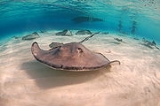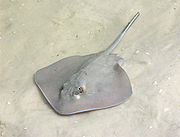
Southern stingray
Encyclopedia
The southern stingray, Dasyatis americana, is a stingray
of the family
Dasyatidae (the Whiptail Stingrays) found in tropical and subtropical waters of the Western Atlantic Ocean
from New Jersey to Brazil. It has a flat, diamond-shaped disc, with a mud brown, olive, and grey dorsal surface and white underbelly (ventral surface). The barb on its tail is serrated and covered in a venomous mucous, used for self defense.
 The southern stingray is adapted for life on the sea bed. The flattened, diamond-shaped body has sharp corners, making it more angular than the discs of other rays. The top of the body varies between olive brown and green in adults, dark grey in juveniles, whilst the underside is predominantly white. The wing-like pectoral
The southern stingray is adapted for life on the sea bed. The flattened, diamond-shaped body has sharp corners, making it more angular than the discs of other rays. The top of the body varies between olive brown and green in adults, dark grey in juveniles, whilst the underside is predominantly white. The wing-like pectoral
fins are used to propel the stingray across the ocean bottom, whilst the slender tail possesses a long, serrated and poisonous spine at the base, used for defence. These spines are not fatal to humans, but are incredibly painful if stepped on. The eyes are situated on top of the head of the southern stingray, along with small openings called spiracles. The location of the spiracles enables the stingray to take in water whilst lying on the seabed, or when partially buried in sediment. Water enters the spiracles and leaves through the gill
openings, bypassing the mouth which is on the underside. Female stingrays can grow to a disc width of 150cm, contrary to the smaller male stingrays that reach maximum size at 67cm.
s, such as alphaeid, penaeid and callianasid shrimp and brachyuran crabs; mollusks, bony fish, and lancelet
s. It feeds by flapping the wing-like pectoral fins to disturb the sand and expose the prey. This bottom-dwelling species is often found singly or in pairs, except in the summer months when it migrates in schools to higher latitudes.
, the southern stingray swims with divers and snorkelers, and are hand fed on a locations such as Stingray City and the Sandbar. On Turks & Caicos, they can be hand fed at a location called Gibbs Cay. Some have become tame enough to be cradled in visitors' arms and feed with pieces of cut up fish. There are concerns that this feeding, and the high levels of interaction with humans, may be having some negative impacts on the behaviour and ecology of the stingrays.
The suction power of their mouth is similar to a very powerful vacuum cleaner.
Stingray
The stingrays are a group of rays, which are cartilaginous fishes related to sharks. They are classified in the suborder Myliobatoidei of the order Myliobatiformes, and consist of eight families: Hexatrygonidae , Plesiobatidae , Urolophidae , Urotrygonidae , Dasyatidae , Potamotrygonidae The...
of the family
Family (biology)
In biological classification, family is* a taxonomic rank. Other well-known ranks are life, domain, kingdom, phylum, class, order, genus, and species, with family fitting between order and genus. As for the other well-known ranks, there is the option of an immediately lower rank, indicated by the...
Dasyatidae (the Whiptail Stingrays) found in tropical and subtropical waters of the Western Atlantic Ocean
Atlantic Ocean
The Atlantic Ocean is the second-largest of the world's oceanic divisions. With a total area of about , it covers approximately 20% of the Earth's surface and about 26% of its water surface area...
from New Jersey to Brazil. It has a flat, diamond-shaped disc, with a mud brown, olive, and grey dorsal surface and white underbelly (ventral surface). The barb on its tail is serrated and covered in a venomous mucous, used for self defense.
Description

Pectoral
Pectoral may refer to:* Pectoral cross, a cross worn on the chest* a decorative, usually jeweled version of a gorget* Pectoral , often iconographic with hieroglyphs* Pectoralis major muscle, commonly referred to as "pectorals" or "pecs"...
fins are used to propel the stingray across the ocean bottom, whilst the slender tail possesses a long, serrated and poisonous spine at the base, used for defence. These spines are not fatal to humans, but are incredibly painful if stepped on. The eyes are situated on top of the head of the southern stingray, along with small openings called spiracles. The location of the spiracles enables the stingray to take in water whilst lying on the seabed, or when partially buried in sediment. Water enters the spiracles and leaves through the gill
Gill
A gill is a respiratory organ found in many aquatic organisms that extracts dissolved oxygen from water, afterward excreting carbon dioxide. The gills of some species such as hermit crabs have adapted to allow respiration on land provided they are kept moist...
openings, bypassing the mouth which is on the underside. Female stingrays can grow to a disc width of 150cm, contrary to the smaller male stingrays that reach maximum size at 67cm.
Behaviour and ecology
The southern stingray is an opportunistic forager, feeding on small crustaceanCrustacean
Crustaceans form a very large group of arthropods, usually treated as a subphylum, which includes such familiar animals as crabs, lobsters, crayfish, shrimp, krill and barnacles. The 50,000 described species range in size from Stygotantulus stocki at , to the Japanese spider crab with a leg span...
s, such as alphaeid, penaeid and callianasid shrimp and brachyuran crabs; mollusks, bony fish, and lancelet
Lancelet
The lancelets , also known as amphioxus, are the modern representatives of the subphylum Cephalochordata, formerly thought to be the sister group of the craniates. They are usually found buried in sand in shallow parts of temperate or tropical seas. In Asia, they are harvested commercially as food...
s. It feeds by flapping the wing-like pectoral fins to disturb the sand and expose the prey. This bottom-dwelling species is often found singly or in pairs, except in the summer months when it migrates in schools to higher latitudes.
Reproduction
Mating stingrays are rarely encountered in the wild. During one rare occasion, the male was observed closely following the female, and then biting her before grasping the female’s pectoral fins with his mouth, and then copulating. It is thought that southern stingrays are polyandrous, as a female was observed mating with two males in quick succession. The southern stingray is ovoviviparous, a method of reproduction in which the egg develops within the female’s brood chamber. The pups hatch from their egg capsules inside the mother, and are born soon afterwards. In captivity, gestation lasted 135 to 226 days, after which a litter of two to ten young were born.Human Interaction
In many parts of the Caribbean such as Grand Cayman Island and AntiguaAntigua
Antigua , also known as Waladli, is an island in the West Indies, in the Leeward Islands in the Caribbean region, the main island of the country of Antigua and Barbuda. Antigua means "ancient" in Spanish and was named by Christopher Columbus after an icon in Seville Cathedral, Santa Maria de la...
, the southern stingray swims with divers and snorkelers, and are hand fed on a locations such as Stingray City and the Sandbar. On Turks & Caicos, they can be hand fed at a location called Gibbs Cay. Some have become tame enough to be cradled in visitors' arms and feed with pieces of cut up fish. There are concerns that this feeding, and the high levels of interaction with humans, may be having some negative impacts on the behaviour and ecology of the stingrays.
The suction power of their mouth is similar to a very powerful vacuum cleaner.

